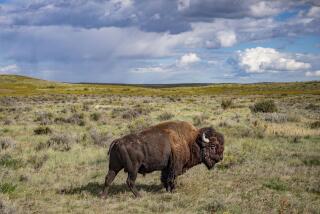North Dakota Substitutes ‘Art’ for Natural Wonders
- Share via
STEELE, N.D. — The world’s largest rock pile didn’t make the cut. The tallest haystack probably would have been just blown over by the winds of the Upper Plains.
And so, after a couple of years of toying with giant ideas, Susie White went with the bird option--namely, the 40-foot-tall sandhill crane anchored deep in the ground by her motel parking lot.
This bird of steel is truly big, and just odd enough, White hopes, to capture the bored eyes of motorists driving along this largely featureless stretch of North Dakota highway.
“I look out the window sometimes and see people drive up and they laugh and laugh at the bird,” says White, beaming with pride. “But they’re stopping, and that’s what’s important.”
And if only a few of each day’s 5,500 passing motorists stop by her Lone Steer motel and steakhouse, it’ll have been worth it, she says.
But is it just a rather desperate gimmick for roping in customers? Or is there more to this curious spectacle of the big bird and all the other bizarre statues that dot the Northern Plains?
Passing the giant buffalo, then the giant bird, the giant cow, the giant grasshopper and the giant turtles, you can’t help thinking you’ve walked in on the punch line of an obscure Upper Midwestern joke. Or maybe, as one expert suggests, it’s a way of carving out an identity in a landscape of unremitting sameness.
In New Salem, in west-central North Dakota, lives 38-foot-tall New Salem Sue, surely the world’s largest Holstein cow. Made of steel and fiberglass, she stands halfway up a small butte along Interstate 94, the state’s main east-west highway.
Elsewhere on I-94, in Jamestown, looms the 60-ton buffalo, also the world’s largest. Bottineau, Turtle Lake and Dunseith offer variations of oversize turtles, including one riding a giant snowmobile and another made of automobile wheels.
On a 32-mile stretch of road in southwestern North Dakota known as the Enchanted Highway, retired schoolteacher Gary Greff has created his own horde of giants--a family of tin people, a covey of pheasants, a 40-foot-long grasshopper. More, he says, are in the works.
Those who own them tend to give the same explanation: They’re an attraction. “Where else are you going to see a gorilla in a field?” asks 88-year-old Bert Miller of Harvey, N.D. “When people think of Harvey, they think of Og.”
Og is, in fairness, only half a gorilla--36 feet high from the bellybutton up. Made of wire and thick papier-mache, he once graced a “frontier village” in Mandan, just west of Bismarck. When that business folded years ago, a farm-tools dealer in Harvey, pop. 2,200, bought the King Kong-like monster to put on his roof.
Insurance concerns nipped that idea, and eventually Miller bought Og and placed him in an empty field along a straight stretch of Highway 52 from Jamestown to Minot.
“He’s brought an awful lot of attention to Harvey,” Miller says. “But I can’t say definitively that business in town has increased on account of him.”
Not everyone appreciates Og. One farmer, who declined to give his name for fear of being labeled a sourpuss, said he finds the gorilla’s presence “kinda weird.”
While some say the goal is money, others see it as a way for towns to distinguish themselves from their neighbors.
“I don’t think any of these small towns believe these are tourist attractions like Disneyland’s a tourist attraction,” says Dan Fesenmaier, director of the University of Illinois Tourism Research Laboratory. “But for the community itself, for many of these communities, it becomes a defining element for them, a sense of identity.”
Robert Tubbs is an unabashed giants fan. As director of recycling for the North Dakota Health Department, he takes frequent drives around the state and makes a point of visiting the statues. In 1996 he compiled a directory of North Dakota’s “outdoor sculptures.”
He categorizes most into three distinct groups: commercial, to advertise a business; civic, to honor a community’s history or industry; and “concrete dementia,” a term he borrowed from Roadside America, an online guide to odd attractions around the country.
“Concrete dementia is the retired guy, the insane guy who has nothing to do so he builds some giant, weird thing,” Tubbs says. “Obviously, he’s a little different from the rest of us.”
For all his research, Tubbs still has a tough time explaining the popularity of the giants to outsiders.
“I really don’t know why. Maybe the answer lies in ethnicity. We have a lot of Scandinavians and Germans. Maybe they are more prone to it,” he says with a laugh. “It’s definitely a Midwest thing. The East and West coasts are too hip for this.”
Maybe, he adds, it has something to do with religion. “Maybe, subconsciously, they are doing this to build something bigger than themselves.”
Lois Hanson, who stopped with her husband, Lavern, to see the world’s largest buffalo in Jamestown, offered a simpler theory: “Maybe they’re compensating for a lack of mountains.”
Whatever the reason, she added, gazing up at the three-story-high creature, “it sure is impressive.”
The Hansons, of Fairfield, Wash., were on their way to Virginia when highway billboards advertising the giant bison pulled them off the interstate. They stayed in town for lunch.
In New Salem, home of Sue the Holstein, newspaper publisher Rocky Rapsavage is skeptical about bringing ethnicity or religion into the debate.
“I don’t know about that,” he says. “But I suppose anything’s possible.”
New Salem Sue was built in 1974 to honor the area’s dairy farmers. It cost $40,000, paid with donations from dairymen, farmers, businessmen and area residents.
Rapsavage says attracting tourists wasn’t the original intent but became a “pretty good byproduct.”
Several thousand people visit Sue every year, and many also buy gasoline and groceries.
“She’s become something the community is really proud of,” Rapsavage says.
Obviously. The high school’s athletic teams--even the boys’ football team--are known as the Holsteins.
New Salem Sue has her own ballad, which includes the refrain:
Her presence shows
That New Salem grows
With milk producers’ yields.
We’ve got the cow,
World’s largest cow, That looks across our fields.
Rapsavage’s weekly newspaper, the New Salem Journal, boasts “Home of the World’s Largest Holstein Cow” under the newspaper flag. And each year, the Lions Club, which is in charge of Sue’s upkeep, throws a giant pancake feed under her belly.
Susie White, whose crane went up this summer, knows it’ll never rival Mt. Rushmore. But “wouldn’t it be funny,” she muses, “if [the state] ended up one day having the world’s largest collection of the world’s largest stuff?”
More to Read
Sign up for The Wild
We’ll help you find the best places to hike, bike and run, as well as the perfect silent spots for meditation and yoga.
You may occasionally receive promotional content from the Los Angeles Times.






